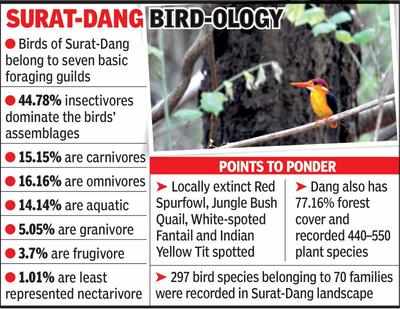
Surat: The forest in South Gujarat – from Surat to Dang – is a bird paradise where various avian species have made their habitat in the lush green forests of the northern part of the Western Ghats.
This was confirmed by a recent study on avian diversity, titled ‘Birds of Surat-Dang: A Consolidated Checklist of 75 Years (1944–2020)’ published in the Journal of Threatened Taxa.
The study lays special emphasis on the remarkable bird records and hotspots of the northern part of the Western Ghats of Gujarat.
The paper is co-authored by Nikunj Jambu with Avian Biology and Wildlife Biology, Department of Zoology, The Maharaja Sayajirao University of Baroda as well as Kaushal Patel of the Wildlife Conservation Society (Bengaluru).
“A total of 297 species belonging to 21 orders and 70 families have been recorded from the Surat-Dang landscape, representing 51.03% of the recorded avifauna from Gujarat and 22.85% of the bird species of India. Both protected areas – Complete Wildlife Sanctuary (PWS) and Vansda National Park (VNP) – are home to 77.44% (PWS) and 65.32% (VNP) of the 297 species recorded from the landscape. High diversity of habitat over the past 125 years (1897–2020) This may be due to the rapid change in fidelity,” the researchers said.
Speaking to TOI, Kaushal said, “We have reported a total of 297 bird species belonging to 70 families and 21 orders including PWS along with the first record of Nilgiri wood-pigeon in Gujarat. We re-reported the Red Spurfowl, Jungle Bush Quail, White-spotted Fantail and Indian Yellow Tit, which were suspected to be locally extinct from PWS.
The authors say that according to the IUCN Red List, 19 species fall into different categories. Seven each were classified as Near Threatened and Vulnerable, two each in Critically Endangered and Threatened categories, while one was classified as data deficient.
The record of the Western Ghats endemic Nilgiri wood pigeon from Surat-Dang is an addition to the state’s bird list.
“Despite being part of an endemic bird area and a global biodiversity hotspot, the PWS and VNP, designated landscapes, have poorly documented avifanal diversity. Few studies have been conducted on birds since the collection of Dr. Salim Ali in 1944–48. ,” the researchers said.
The duo surveyed both protected and non-protected areas in 2012-13 and 2015-2018 for documentation and presented a consolidated checklist of birds from the surveys as primary data.
FacebookTwitterLinkedinE-mail
.